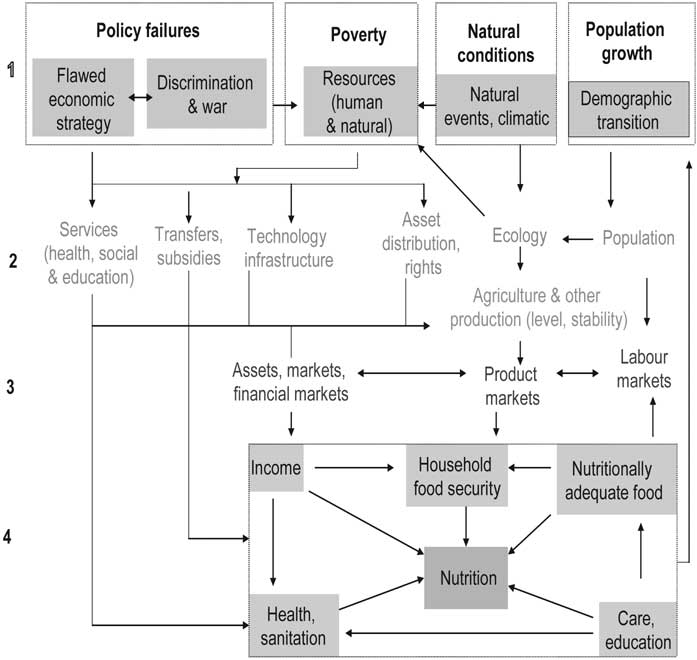Box 2-10.Evolution of the term food security.
Food security [is] a situation that exists when all people, at all times, have physical, social and economic access to sufficient, safe and nutritious food that meets their dietary needs and food preferences for an active and healthy life. (FAO, The State of Food Insecurity 2001)
Food sovereignty is defined as the right of peoples and sovereign states to democratically determine their own agricultural and food policies.
The term food security originated in international development literature in the 1960s and 1970s (Ayalew, 1997; Stringer, 2000; Ganapathy et al., 2005; Windfuhr and Jonsén, 2005) and public interest in global and domestic food security grew rapidly following the oil crisis and related food crisis of 1972- 74 (Saad, 1999; Stringer, 2000; Clover, 2003), the subsequent African famine of 1984-85, and emergence of growing numbers of food banks in developed nations. Food security is a term with many definitions, each used differently in international, national and local contexts (Ganapathy et al., 2005). Early definitions of food security focused on aggregate food supplies at national and global levels (Clover, 2003). Over time the concept evolved and expanded to integrate a wide range of food-related issues reflecting the complexity of the role of food in human society. Much of the paradigm shift of the concepts and definitions of food security over the years can be attributed to NGO and civil societies' movements in the early 1990s that led to the birth of the concept food sovereignty.

Figure 2-8. Determinants of nutrition security: Basic causes and links. Source: FAO, 1996a.
Notes: (i). Basic causes; (ii). Structural/institutional conditions, areas of public action; (iii). Market conditions; (iv) Micro-level conditions (household, intra-household, gender).
agricultural markets, further increasing specialization and prompting the emergence of contractual farming and vertical integration for supply and quality control, and development of special-use, high-value commodities (Barrett et al., 1999) particularly of farmed fish, livestock and specialty crop operations (Knudsen et al., 2005). Concerns have been raised regarding the impact of these structural changes on the rural poor (Lindstrom and Kingamkono, 1991; Welch and Graham, 1999; Grivetti and Olge, 2000) and marginalized urban populations.
Food safety. The right of everyone to have access to safe and nutritious food is reaffirmed by the Rome Declaration on World Food Security. Yet food-borne poisonings and illnesses represent a major daily health threat and results in significant economic costs in both developed and developing countries in spite of significant progress in the regulation of food standards, medicine, food science and technology (Box 2-11; FAO, 1999b).
The globalized food system, although it is subject to high controls and standards, can still threaten food safety, particularly for marginalized populations in industrialized and developing countries (Welch and Graham, 1999; Mol and Bulkeley, 2002). High-profile risks such as those associated with bovine spongiform encephalopathy (BSE); Belgian dioxin chickens; vegetables contaminated with Chernobyl nuclear fallout or with dioxins from waste-burning plants; and GMOs have been profiled in recent decades. Other environmental and health threats, less reported in the media, are also contributing to widespread concern about the GFS. As food passes over extended periods of time through the food production, processing, storage and distribution chain, control has become difficult, increasing the risks of exposing food to intentional, undetected or involuntary contamination or adulteration. The use of pesticides and fertilizers, the use of hormones in meat production, large-scale livestock farming, and the use of various additives by food processing industries are among the food safety concerns that are associated with the GFS. In developing countries, GFS safety concerns are compounded by rampant poverty negatively influencing policy compliance and poor infrastructure for enforcement of food control systems. Other threats to food safety in developing countries are offered by inadequate social services and service structures (potable water; health, education, transportation); population growth; high incidences of communicable diseases including Acquired Immunodeficiency Syndrome (AIDS); competitive markets and trade pressures that may encourage shortcuts that compromise food safety (CSPI, 2005).
Access to good quality food has been humankind's main endeavor from the earliest days of human existence (FAO, 1999b) with governing authorities codifying rules to protect consumers from dishonest practices in the sale of food. The first general food laws in modern times were adopted during the second half of the nineteenth century; subsequently basic food control systems were established to monitor compliance.
Efforts to deal with hazardous agents (pesticides and food additives) began in the 1940s and 50s when toxicologists derived limits on exposure for protection of human health (Rodricks, 2001). A major step in advancing a sci-